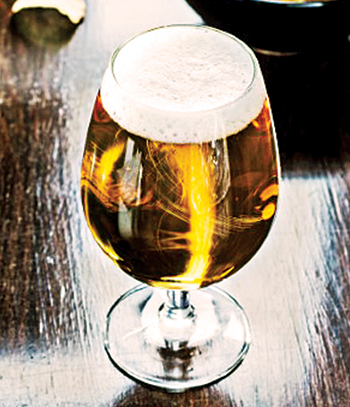Where is Hard Cider Headed?
The small alcohol segment has seen success in off-premise sales. Will that channel remain the best chance at growth?
Hard cider currently makes up less than 2 percent of beverage alcohol market share in the United States, but with ongoing consumer interest in exploring alternative beverages as well as a demand for gluten-free offerings, cider hopes to harness its momentum to become a more mainstream beverage for American drinkers—especially at the end of each year.
“We typically see Q4 as the peak of our cider business, and women—64 percent—are the primary purchasers,” explains Randy Ornstein, senior director of beverages at Gopuff. (Gopuff acquired BevMo! in 2020 and handles national retail sales.) This spike in sales can be attributed both to the harvest season and a predilection towards traditional fall flavors—including apples—but is also thanks in part to evolving sales channels and marketing tactics to entice new consumers.
Kelli McCusker, head of marketing for Angry Orchard, says that they’ve managed to become the far-and-away leading cider brand in the U.S. thanks to both consumer education, product innovation, and ever-changing pack formats “that meet drinker occasion drivers” as well as “more cans, single-serve options and variety pack news.”
Cider’s Current Trajectory
This fixation on single-serve options and variety packs indicates an emphasis in off-premise sales, where cider has traditionally seen the most success in the United States. Key findings in a study done by Fior Markets report that the global cider market is expected to reach $5.43 billion by 2026, with cans driving the largest segment of growth in both off- and on-premise sales.
A 2018 Hard Cider Business Benchmark Survey by the Penn State Extension program explains that local and regional brands continue to drive the most growth across cider, with certain regional brands substantially increasing off-premise sales in markets such as Texas, Oregon, and North Carolina. But they’re not the only places poised to become cider hot spots.
“I have seen more canned ciders offerings in local restaurants here in California, specifically outside of San Francisco,” says Amy Gutierrez, beer and DSO category manager at BevMo! Gopuff data corroborates Gutierrez’s observation, noting certain metro areas are experiencing an unexpected influx in cider purchasing. “In looking at data over the past month (Sept. 1 – Oct. 27), the metros over-indexing on purchasing hard ciders are San Francisco, Boston, Portland, [OR]; Philadelphia, and Washington D.C.,” explains Ornstein.
Penn State Extension’s survey also collected data from nearly 300 respondents making cider anywhere from 1,000 gal/year to over 100,000 gal/year to find what market channels small, medium, and large producers gravitate towards. The largest segment of respondents, who are making between 1,000 and 10,000 gal/year, indicate a strong preference towards selling wholesale kegs, bottles, and cans versus bulk wholesale. This preference echoed through every respondent segment, with data also showing 71.85 percent of all respondents reporting they also sell cider by the glass in a tasting room setting.
According to McCusker, Angry Orchard knows that growth potential lies in both on-premise as well as off-premise sales, especially as more bars, restaurants, and eateries recover from the pandemic and regain the flexibility to experiment with drinks lists. “While the majority of Angry Orchard lives in the off-premise, on-premise remains a dominant channel of strength for the brand,” she says. “While on- and off-premise will continue to be our focus, we’re keeping an eye on where drinkers are going by staying well-connected to emerging channels and the formats needed to maintain relevancy.”
IRI data from 2017 to the 52 weeks ending on October 10, 2021 shows hard cider growth to be relatively flat after some moderate gains over the past few years, but the best gains and/or long-term reliability coming from grocery stores and mass merchandiser outlets. These channels are also where hard seltzer sales have stabilized, according to the same data, which IRI suggests has hindered potential cider growth in off-premise. However, the data analytics and market research company is quick to predict future traction for cider in on-premise channels as casual and quick-serve establishments continue to embrace RTDs like cider. Despite hard seltzer cutting into hard cider’s possibilities, increased acceptance of RTDs across multiple consumer demographics means the future is wide open across multiple channels.
What’s The Next Big Cider Channel?
When McCusker describes emerging channels, she’s talking about technology-based options like e-commerce and “click and collect shoppability.” Neither of these will replace on- or off-premise, she says. But they will help tailor future product offerings based on data—some of which has already resulted in new SKUs. McCusker says rotating seasonal variety packs specifically geared for off-premise have resulted in increased sales. “Our current Fall Haul Variety Pack is +23% L4W,” she says.
BevMo!’s Gutierrez believes that more packaging options will help maintain off-premise sales for the cider industry. “I see the future heading to different sizes of packages: 12-pack variety and 19.2 oz singles,” she predicts. But for smaller producers who rely more heavily on on-premise sales, it will be flavor variety that cements success. “I see smaller local items building their portfolios to include different styles, to build on the success of their flagship brand.”
This support of local brands in local markets will likely be echoed by retailers hoping to capture a bigger slice of cider sales as well. “We’ll continue to focus on our current strategy of offering a few bigger cider brands nationally, and leaning into local offerings,” says Gopuff’s Ornstein. “As the success of hyper local craft beers accelerates, we expect many retailers to ensure they have a strong cider portfolio in the future.”
He also echoes Gutierrez in the belief that a variety of packaging sizes, as well as clearly marked low-calorie and gluten-free marketing, will be crucial for brand longevity. Consumer education, whether it be from a liquor store clerk, bartender, or marketing materials, will also require implementation for correcting misconceptions and attracting potential cider converts.
These types of strategies have worked in other industries—Ornstein points to FMBs and hard seltzers as examples of adjacent segments at the forefront of product innovation. He then points out that cider’s relative nascence compared to more established segments like craft beer may allow cider to learn from history and even leverage cross-purchasing trends to capture consumers who have overlooked cider before now.
“As these [cider] brands continue to branch out into different styles of alcohol, we could see cider houses become popular destinations, like craft breweries, in the future,” he says.
These statistics and observations indicate that success in the North American cider industry comes from relatively equal prioritization of both on- and off-premise sales, all while keeping an eye on emerging technologies and capitalizing on seasonality to ensure long-term success in all channels. Will hard cider be the new craft beer? Only time—and data—will tell.


Receive your free magazine!
Join thousands of other food and beverage professionals who utilize BevNET Magazine to stay up-to-date on current trends and news within the food and beverage world.
Receive your free copy of the magazine 6x per year in digital or print and utilize insights on consumer behavior, brand growth, category volume, and trend forecasting.
Subscribe

